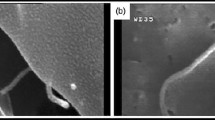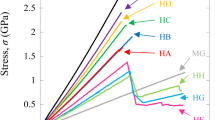Abstract
Glass fiber polymer composites have high strength, low cost, but suffer from poor performance in fatigue. Mechanisms for high-cycle (>104 cycles) fatigue failure in glass fiber composites consist primarily of matrix-dominated damage accumulation and growth that coalesce and propagate into the fibers resulting in ultimate fatigue failure. This investigation shows that the addition of small volume fractions of multi-walled carbon nanotubes (CNTs) in the matrix results in a significant increase in the high-cycle fatigue life. Cyclic hysteresis measured over each cycle in real time during testing is used as a sensitive indicator of fatigue damage. We show that hysteresis growth with cycling is suppressed when CNTs are present with resulting longer cyclic life. Incorporating CNTs into the matrix tends to inhibit the formation of large cracks since a large density of nucleation sites are provided by the CNTs. In addition, the increase in energy absorption from the fracture of nanotubes bridging across nanoscale cracks and nanotube pull-out from the matrix is thought to contribute to the higher fatigue life of glass composites containing CNTs. High-resolution scanning electron microscopy suggests possible mechanisms for energy absorption including nanotube pull-out and fracture. The distributed nanotubes in the matrix appear to inhibit damage propagation resulting in overall improved fatigue strength and durability.








Similar content being viewed by others
References
Dharan CKH (1975) ASTM Spec Tech Publ 569:171
Dharan CKH (1975) J Mater Sci 10:1655. doi:https://doi.org/10.1007/BF00554927
Hahn HT, Kim RY (1976) J Compos Mater 10:156. doi:https://doi.org/10.1177/002199837601000205
Degrieck J, Van Paepegem W (2001) Appl Mech Rev 54(4):279. doi:https://doi.org/10.1115/1.1381395
Saghizadeh H, Dharan CKH (1986) J Eng Mater Technol: Trans ASME 108(4):290
Ren Y, Li F, Cheng HM, Liao K (2003) Adv Compos Lett 12(1):19
Ganguli S, Aglan H (2006) J Reinforc Plast Compos 25(2):175. doi:https://doi.org/10.1177/0731684405056425
Gojny FH, Wichmann MHG, Fiedler B, Bauhofer W, Schulte K (2005) Composites A 36:1525. doi:https://doi.org/10.1016/j.compositesa.2005.02.007
Kim JA, Seong DG, Kang TJ, Youn JR (2006) Carbon 44:1898. doi:https://doi.org/10.1016/j.carbon.2006.02.026
Wong M, Paramsothy M, Xu XJ, Ren Y, Li S, Liao K (2003) Polymer 44(25):7757. doi:https://doi.org/10.1016/j.polymer.2003.10.011
Wang SS, Chim ES-M (1983) J Compos Mater 17:114. doi:https://doi.org/10.1177/002199838301700203
Stinchcomb WW, Reifsnider KL (1979) ASTM Spec Tech Publ 675:782
Owen MJ, Howe RJ (1972) J Phys D App Phys 5(9):1637
Dharan CKH, Tan TF (2007) J Mater Sci 42(6):2204. doi:https://doi.org/10.1007/s10853-007-1498-9
Fan Z, Hsiao KT, Advani SG (2004) Carbon 42:871. doi:https://doi.org/10.1016/j.carbon.2004.01.067
Acknowledgement
This work was supported in part by a grant from Entropy Research Laboratories, San Francisco, California, USA.
Author information
Authors and Affiliations
Corresponding author
Rights and permissions
About this article
Cite this article
Grimmer, C.S., Dharan, C.K.H. High-cycle fatigue of hybrid carbon nanotube/glass fiber/polymer composites. J Mater Sci 43, 4487–4492 (2008). https://doi.org/10.1007/s10853-008-2651-9
Received:
Accepted:
Published:
Issue Date:
DOI: https://doi.org/10.1007/s10853-008-2651-9




